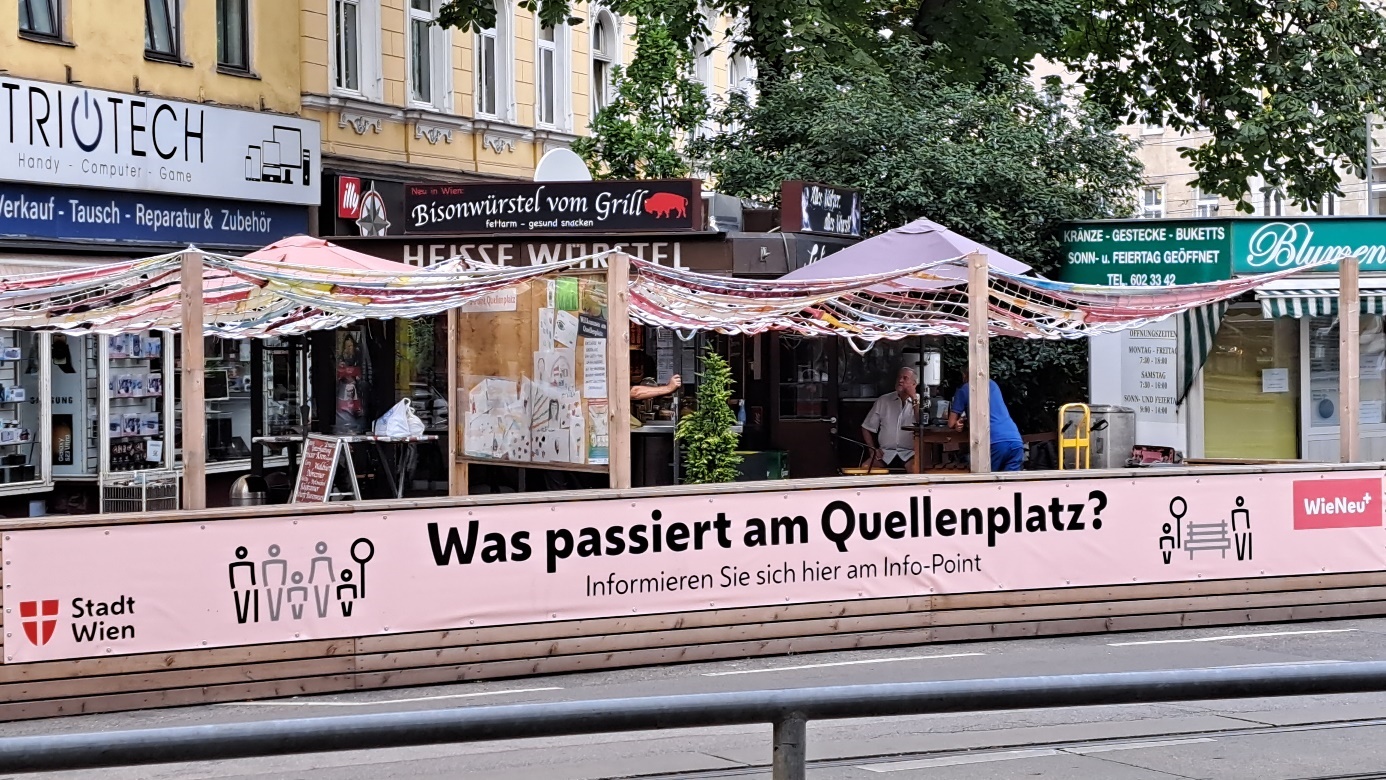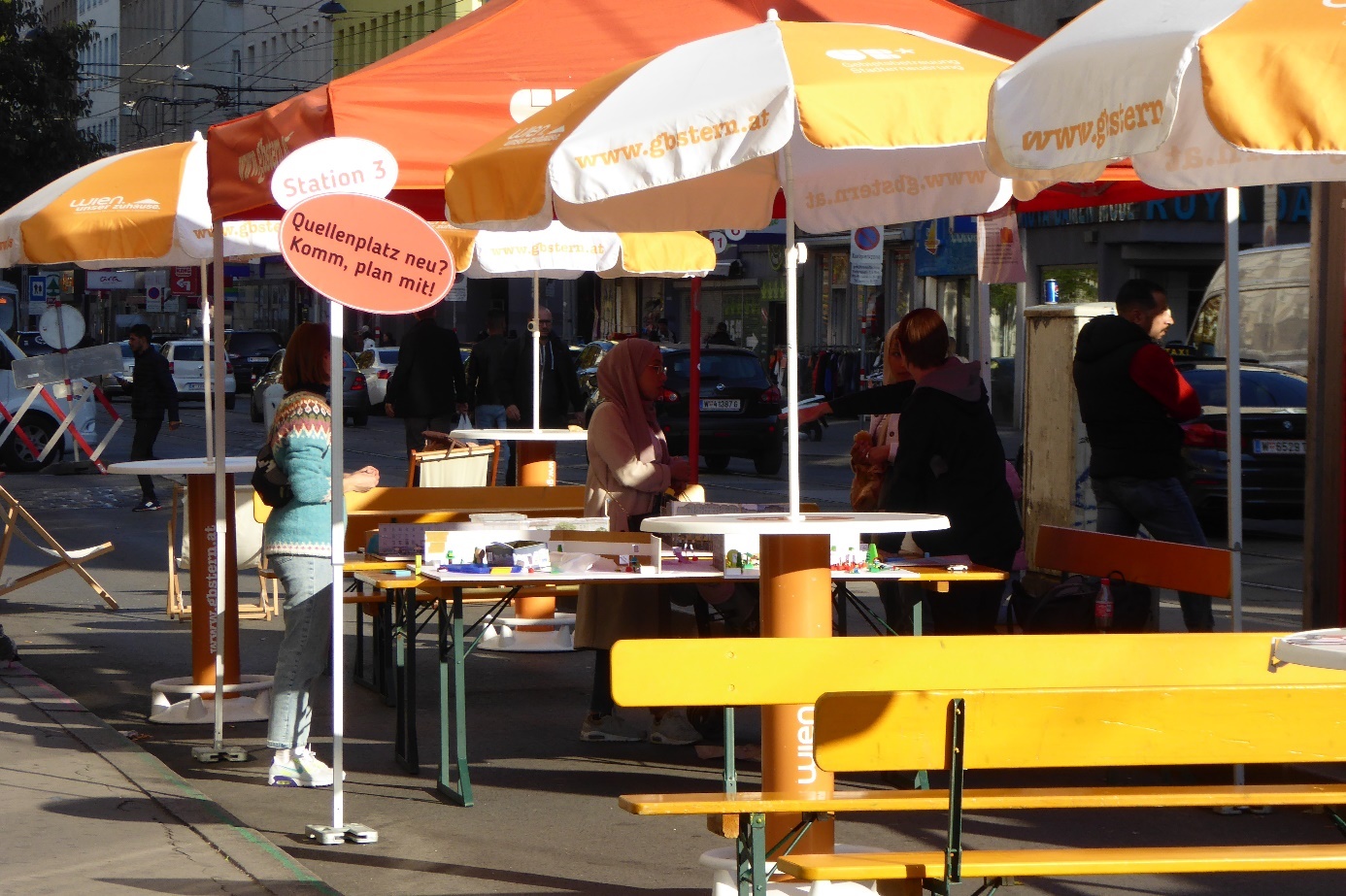12.1 A vision for Quellenplatz square
Partners: MA 19 – Architecture and Urban Design, MA 28 – Road Management and Construction, MA 25 – Technical Urban Renewal, Municipal District Office for the 10th District, GB*East
Quellenplatz is one of the most frequented squares of and an important traffic and transport hub to and from the WieNeu+ programme area in Innerfavoriten. Every day, tens of thousands of people cross Quellenplatz; approx. 30,000 persons use trams in the square, which makes it comparable to such hubs as Westbahnhof or Praterstern.
Its size, very heterogeneous architecture and manifold forms of use characterise this square. Structures range from Gründerzeit multi-apartment buildings, whose austere façades were deprived of their former decorative elements, to municipal housing estates from the 1980s. This is compounded by the crossing of two main MIT thoroughfares as well as of three important tram lines (11, 6, O), four tram stops with refuge islands, numerous shops and kiosks as well as a correspondingly high number of passers-by every day. Scarce greening, which moreover is very heterogeneous with just a few trees of various height and shape, as well as many parking spaces contribute to the fact that this square is increasingly becoming an urban heat island due to the advance of climate change.
Because of this need for renewal, Quellenplatz was defined a focal project for public space in the WieNeu+ programme area. In co-operation with the Municipal District Office, first steps towards a long-term, comprehensive renewal process were taken together with all stakeholders, including residents, businesspeople and pedestrians. In this early phase, strategic decisions are to be sketched and concrete suggestions for improvement voiced by users are to be collected.
WieNeu+ acted as a pioneer for the potential redesign of Quellenplatz over the coming years. In addition to a traffic count, a micro-climate simulation and various participatory formats, WieNeu+ was able to formulate a preliminary strategic basis for planning in close co-ordination with the competent municipal departments.
The implementation of this project will in due course be handled and supervised by the respective municipal departments of the City of Vienna. WieNeu+ will continue to assist and support the project by providing monitoring and knowledge management.

Objectives in the context of WieNeu+:
-
Preparing a “rough plan”, including a feasibility study and cost assessment
-
Meeting the ambitious technical and quality goals of the City of regarding the adaptation to climate change, greening, sustainable mobility, circular economy, energy supply, etc.
-
Involving the inhabitants and local players on the ground
-
Applying new and innovative planning solutions and testing these (e.g. micro-climate simulation, geothermal heat potentials, resource-conserving construction techniques and open space design, façade greening)
-
Taking account of subsidies (ERDF, ) while respecting the technical and quality goals stated above

Outcomes:
-
On the basis of talks with municipal departments and the Municipal District Office as well as a traffic count and various participation formats, the Municipal District Office for the 10 th District commissioned Municipal Department 28 – Road Management and Construction in 2023 to prepare a “general plan”.
-
A co-ordinated system of objectives and priority activities for Quellenplatz was drawn up.
-
The population and local residents were involved by means of several events and personal talks.
-
New and innovative solutions were examined, e.g. in co-operation with Wien Energie, Municipal Department 19 – Architecture and Urban Design, the Co-ordination Unit for Resource Conservation and Sustainability in the Construction Sector at the Executive Group for Construction and Technology and Wiener Wohnen. A micro-climate simulation was commissioned by Municipal Department 22 – Environmental Protection.
Participation process for Quellenplatz
To involve people in the renewal process at an early moment, WieNeu+ made use of various formats to network residents and local players on site. For example, in summer and autumn 2021, the neighbourhood experts of the Urban Renewal Office (GB*) were provided with five eye-catching, oversized models of sensory organs, which were put up in Quellenplatz to ensure low-threshold contacts with people. An open-air workshop in September 2022 served to collect and discuss numerous requests, suggestions and ideas voiced by passers-by. To meet the need for information and involvement, a parklet was set up in the square to motivate interested persons to linger and thus acted as an information hub. Another primary concern of WieNeu+ – as well as of all municipal bodies – was and remains the intensive contact and exchange with local business circles.

Outcomes
The involvement of residents and users of Quellenplatz yielded, inter alia, the following insights and requests:
-
Need for (more) greening, visual improvement of the square
-
Seating should be provided.
-
Measures to improve the overall atmospheric quality of the square, e.g. shade, protection against wind and bad weather, a drinking fountain, water, space to meet, talk, linger (also standing)
-
More cleanliness: a new solution for the waste collection point is required.
-
A re-organisation of the snack stands and outdoor seating of restaurants and cafés was above all requested by stand operators and restaurateurs, many of whom wish for more space for tables, chairs and outdoor seating, even at the expense of currently existing green spaces and trees.
-
More space for non-motorised transport modes
-
Improvement of the situation for pedestrians, e.g. more space for walking, longer green phases of traffic lights, improved signage and spatial orientation as well as safer routes to and from schools
-
More space at public transport stops
-
The parking space issue was the subject of by far the most controversial debate:
-
Some businesspeople consider the existing parking spaces to be very important since their customers buy food to go at their (snack) stands. Others want more parking spaces (also at the expense of cutting down existing trees) as well as the lifting of the restrictions tied to short-term parking.
-
-
Conversely, though, many persons interviewed were aware that additional space for other important forms of use can only be created at the expense of moving and stationary motorised individual traffic (MIT); many persons, too, would like to see a reduction of the effects of MIT, such as noise and hazards for pedestrians.
-
Possibilities for children to play in the square
-
Complementary infrastructure, such as toilets, water dispensers
Micro-climate analysis
Partner: Municipal Department 22 (MA 22) – Environmental Protection
The micro-climate exerts great influence on human wellbeing in a given area. For this reason, Municipal Department 22 – Environmental Protection of the City of commissioned a micro-climate analysis of the area in the context of the WieNeu+ “Grätzlförderung” subsidy scheme.
In addition to a status quo analysis, this method permits simulating the effect of various greening or cooling measures on the micro-climate, which, in turn, provides an idea about where greening interventions could have a particularly cooling effect on the surroundings. This is to be tested concretely in Quellenplatz. The simulation shows by how many degrees the perceived temperature in the square could be decreased by means of greening or cooling interventions.
Objective of micro-climate simulation
Cool spots (e.g. Belgradplatz square) are identified; by the same token, micro-climatically problematic zones in the area studied are likewise spotted on the basis of certain parameters (air temperature, wind, perceived temperature). Suitable measures to curb the urban heat island effect are proposed. Their effectiveness is evaluated in a follow-up analysis of different options.
-
Simulation of the micro-climatic status quo of the entire WieNeu+ area (how hot does it get in the summer months in the entire WieNeu+ area?)
-
Simulation of the micro-climatic status quo of Quellenplatz (how hot does it get in the summer months in the various parts of Quellenplatz?)
-
Simulation of the micro-climatic effect of planning options for larger zones of the WieNeu+ area
-
Simulation of the micro-climatic effect of different greening measures during the planning phase for Quellenplatz

Outcomes
The simulation of the status quo of Quellenplatz (2nd bullet point) was submitted to the Municipal District Office and the relevant municipal departments; moreover, it was integrated into the objectives for the redesign of the square. One key finding is that temperature distribution across Quellenplatz varies markedly depending on the wind direction. Basically, it can be said that zones with relatively high wind velocity present the lowest temperatures, while the physiological equivalent temperature (i.e. perceived temperature, PET) is highest in zones with weak winds. On hot summer days, both the air temperature and PET are very high for all wind directions. Laxenburger Strasse is devoid of trees and green spaces. From there, hot air is advected to Quellenplatz. To improve the situation, it is recommended to redesign the streets leading to Quellenplatz by adding greenery (trees, shrubs, greened surfaces), as these have a cooling effect. Trees and green spaces should be deployed according to the sponge city principle. On the one hand, this prevents road installations from being damaged by roots; on the other hand, plant growth is fostered by continuous water supply. In the case of Quellenplatz, blue infrastructure (water dispensers or spray mist showers) in windless zones can likewise contribute to improving the micro-climate.
The simulation of planning options for several larger zones of the WieNeu+ area (3rd bullet point) takes account of the “Queen Gudrun II” and “Supergrätzl” areas.
Outcomes for the area as a whole
-
Lines of trees along the northern and eastern sides of streets are more efficient for the micro-climate.
-
Well-ventilated courtyards are very valuable for the micro-climate of the surroundings.
-
Streets with north-south orientation tend to overheat much more than streets with east-west orientation.
“Chatbot & Microstories” – “Urban Heat Stories”
Partners: TU Wien – future.lab & library, Luftdaten.at (environmental organisation), – OpenSystems, Wunderbyte (educational technology solutions)
The “Chatbot & Microstories” project is part of the Citizen Science project “Urban Heat Stories”, which investigates the city together with residents and is networked with the OPUSH project of JPI Urban Europe. Individual heat experiences of vulnerable groups in are chronicled under the aegis of the future.lab Research Center of TU Wien. This is to give visibility to the manifold concerns and needs of urban residents in connection with heat against the background of their respective socio-spatial environments.

In the context of the project, Quellenplatz square and its surroundings are studied in depth from the perspective of users: where do residents spend time? What are their experiences with heat in these spots? These experiences are collected as “heat stories”. They form the basis for a pilot chatbot that integrates these heat stories into a dialogue on urban heat.
Objectives:
-
Preparing and implementing an innovative method of capturing qualitative and quantitative data on urban climate and heat experiences around Quellenplatz square
-
Complementing data of municipal climate studies (by MA 18, MA 22, MA 25) by adding data that cannot be captured by means of quantitative modelling
-
Taking account of temperatures and stress factors that are measured and perceived on a small scale in the neighbourhood
-
Broadening the knowledge base regarding socio-spatial contexts of urban heat island effects
Web link to Urban Heat Stories (German) on the future.lab website and to Urban Heat Stories as part of the Österreich forscht website (English)
Two workshops with seniors took place in Favoriten in summer and autumn 2023. Follow-up activities and participatory formats are planned for 2024; the first results and outcomes relating to this process were made available in spring 2024. The project was presented during the Citizen Science Days of the European Citizen Science Association (ECSA) conference in April 2024.
